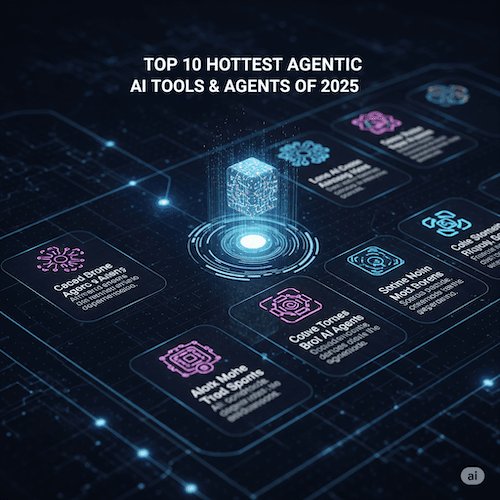2025 is the breakout year for agentic AI systems that don't just respond to prompts but actively plan, execute, and adapt to complete complex tasks autonomously. From enterprise workflow orchestration to coding agents that build entire applications, these tools are transforming how we work.
The AI landscape has evolved dramatically beyond simple chatbots. Agentic AI has been named the top tech trend for 2025, representing autonomous machine agents that move beyond query-and-response to tackle enterprise tasks without human guidance. The AI agent market reached $5.4 billion in 2024 and is projected to grow at 45.8% annually through 2030.
Here are the 10 hottest agentic AI tools and agents making waves in 2025:
1. ChatGPT Operator—OpenAI's Web Automation Agent
ChatGPT Operator is OpenAI's first agent that can go to the web to perform tasks using its own browser, looking at webpages and interacting by typing, clicking, and scrolling. Available to ChatGPT Pro subscribers ($20/month), Operator represents a major leap toward true digital assistants.
What makes it hot: Can autonomously handle online shopping, travel booking, form completion, and meme creation—essentially acting as a digital employee that works in a browser.
Best for: High-value users who need web-based task automation and have the budget for premium AI services.
2. Claude 4 Sonnet + Computer Use - Anthropic's Visual AI Agent
Claude 4 from the newest model family combines sophisticated reasoning with "computer use" capabilities. Claude calls it "computer use," while ChatGPT calls it "operator"—both allowing AI to interact with computers visually. Claude's approach focuses on safety and transparency.
What makes it hot: Superior for coding and writing tasks with real-time visualization through Artifacts, plus experimental computer control capabilities.
Best for: Developers, writers, and analysts who need depth over breadth in AI assistance.
3. Devin AI—The Autonomous Software Engineer
Devin is capable of performing software development independently, building complete web applications with Python servers and React frontends. Users report building entire SaaS products in days without hiring developers.
What makes it hot: Working with Devin is exactly like working with a developer—it can access IDEs, GitHub, terminal, UI, and more, completing tasks, testing them, and submitting PRs.
Best for: Product managers, entrepreneurs, and companies looking to automate low-complexity development tasks.
4. IBM Watsonx Orchestrate—Enterprise Workflow Automation
IBM's Watsonx Orchestrate allows businesses to deploy AI "digital employees" that connect across apps (email, calendars, CRM, HR systems) and perform multi-step business processes autonomously.
What makes it hot: Enterprise-grade reliability with the ability to handle complex hiring workflows—screening resumes, scheduling interviews, and updating HR systems independently.
Best for: Large enterprises needing secure, compliant automation across multiple business systems.
5. Manus AI—China's Multi-Capable Agent
Manus AI is China's first agentic AI chatbot that can complete tasks end-to-end, working asynchronously in the cloud and autonomously completing tasks on freelancing platforms like Upwork and Fiverr.
What makes it hot: Manus AI avoids redundant tasks, recognizing duplicated content or previously completed tasks and refraining from unnecessary repetition—showing advanced task optimization.
Best for: Freelancers and businesses looking for comprehensive task automation across multiple platforms.
6. Microsoft AutoGen—Multi-Agent Conversation Framework
AutoGen is Microsoft's enterprise-focused framework for building conversational multi-agent systems that can generate, execute, and debug code in secure environments.
What makes it hot: Enables teams of AI agents to collaborate on complex problems, with enterprise-grade security and comprehensive error handling.
Best for: Enterprise development teams requiring production-grade reliability and strict compliance requirements.
7. CrewAI - Role-Based Agent Teams
CrewAI focuses on role-based approaches to multi-agent systems, creating collaborative "crews" of specialized agents that work together on complex tasks.
What makes it hot: Perfect for scenarios requiring intelligent teamwork—research, data analysis, and content creation that benefits from multiple AI perspectives.
Best for: Organizations with complex workflows that can be broken into specialized roles and collaborative tasks.
8. Relevance AI - Visual Workflow Designer
Relevance AI provides a comprehensive platform for building and managing autonomous agents within enterprise environments, featuring a visual workflow builder for both technical and non-technical users.
What makes it hot: The no-code/low-code approach makes agentic AI accessible to business users, not just developers.
Best for: Enterprises wanting to democratize AI agent creation across different skill levels.
9. LangGraph—Graph-Based Agent Orchestration
LangGraph is built on top of LangChain and helps organize AI tasks using a graph-based structure, letting developers design workflows with clear steps, loops, branches, and memory.
What makes it hot: Provides precise control over complex agent interactions and state management—essential for sophisticated multi-step workflows.
Best for: Developers building complex applications requiring structured logic and multiple moving parts.
10. Zapier Agents—No-Code Automation Powerhouse
Zapier Agents is an experimental AI workspace where you can teach AI agents to work across thousands of apps using a simple chatbot interface.
What makes it hot: Creating your own AI agent is as simple as using ChatGPT, with access to thousands of apps and automatic data syncing.
Best for: Small to medium businesses wanting easy AI automation without technical complexity.
What's Driving the Agentic AI Boom?
48% of enterprises are already piloting agentic AI solutions as of Q1 2025. The appeal is clear: these systems offer higher autonomy, which equals greater agility, adapting to changing conditions in real-time without waiting for scripted rules.
The key differentiator? Unlike generative AI tools that primarily focus on creating content based on prompts, agentic AI tools create systems that actively perceive, reason, act, and learn, functioning more like autonomous digital assistants.
The Bottom Line
2025 marks the transition from AI that assists to AI that acts. Whether you're looking to automate coding, orchestrate enterprise workflows, or create specialized agent teams, the tools above represent the cutting edge of autonomous AI systems.
The race is on, and early adopters are already seeing transformative results. The question isn't whether agentic AI will reshape work—it's which tools will power your digital workforce.
Ready to explore agentic AI for your organization? Start with the tool that best matches your primary use case, then scale from there as you build confidence in autonomous AI capabilities.
